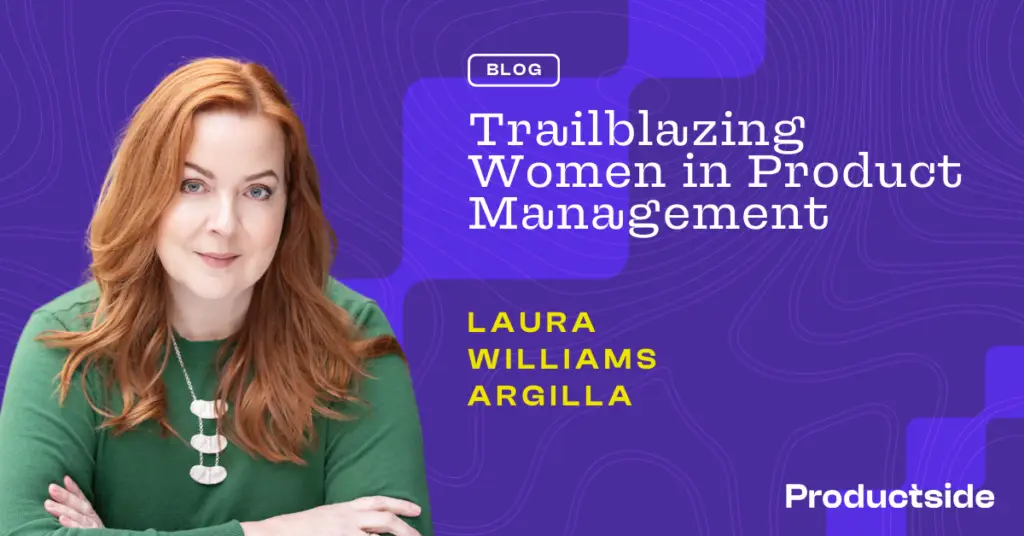
Product Management Predictions for 2026: The New User, New Metrics, and New Rules
Product management isn’t breaking. But many of the assumptions we’ve built it on are. These product management predictions for 2026

For our next installment of our Women in Product Management Series, I interviewed
Laura Williams Argilla, Creative Product Executive.
Nicole: Welcome Laura, I’m very excited for you to share your insights and experiences in the world of Product Management.
Laura: Thank you for having me, Nicole, it’s good to be here.
Your LinkedIn profile bio says you are a lifelong storyteller. What role did that passion play in guiding you into a career in Product Management?
I started with an undergraduate degree in broadcasting because I wanted to do educational television, having been inspired by Mr. Rogers as a kid. I was working at an art college in San Francisco, running the technical side of the motion pictures department and training editors, when I was contacted by a recruiter looking to fill a quality engineering role at Adobe. I didn’t know what quality engineering was, but I knew I wasn’t an engineer. They explained the role was using the tools to discover what’s wrong so they can fix it. I didn’t know that was a thing, but it sounded amazing. I went to work at Adobe on the premier team. This was in 2000 when Product Management was still evolving into what it is today. In that role, because I had the direct experience of being an editor, working with editors, and understanding film and television, I did a lot of things that are now considered Product Management, like doing user requirements, helping design the features, and prioritization. I was able to understand the user perspective and bring that into a technical environment and explain it with storytelling: this is why they need it, this is how they’re using it, this is why what we have right now isn’t working. I refer to it as translating because different roles have different needs for the kind of story that you tell. For example, the Quality Engineer is going to look at how do I break it? How do I test it? How do I make sure it’s not going to fail? Whereas the Product Manager is thinking about how we’re fixing this thing that will make your life better. It’s about how you share the feelings and needs of the user in a way that people can easily connect to. I think the core of that is storytelling.
The most inspiring thing for me is the understanding of the value of Product Management, which hasn’t always been the case.
That’s great you pursued that role despite the title. And what change you have seen in Product Management over these 20 plus years. What is really inspiring you now in the world of Product Management?
There’s a lot in Product Management that’s inspiring. And then there’s a lot that is evolving in a way that I’m not sure is helping us. But the most inspiring thing for me is the understanding of the value of Product Management, which hasn’t always been the case. When I first started, people lumped Product Management in with Marketing as though it were just getting something into market and not the whole thought process on how to evolve the product. How do we design for the future? How do we understand the users in a way that’s meaningful and then measure how we’re doing? Making sure that the value has real impact is probably the most inspiring thing. I also like how we’re reaching a diverse set of Product Managers. We’re not just getting the typical engineer turned Product Manager, which is not necessarily a bad career progression, but it’s different when you have people from industry or with a different background come in and have fresh eyes on a product space. More people, more voices, help represent a broader audience in the end. That’s inspiring.
The diverse voice from your Product Management team helps connect with a diverse audience of customers for sure. You touched on some challenges you’re seeing arise in Product Management. Do you want to expand on that?
We have gone down the path of being able to measure and value everything, and I worry that we go so far down the path of what is measurable that we forget that there are some qualitative traits within good products that are more difficult to measure. Additionally, certain types of products have a broader scope than a single button. I can convince somebody to click a button, but is that the ultimate action that needs to be taken to be successful? How do we help people if we’re exposing information? How do we know we’re exposing the right information? It’s not clear if we’ve done that necessarily, because the outcome could be disconnected. We need to get back into balance, acknowledging the quantitative that we can measure, but also remembering that we’re making tools for human beings who need to be inspired by the tool. We need to understand how they work and how their world comes together, what piece of the puzzle our products play in that, and then get one step back from thinking, “I can measure this”, to thinking, “how does this influence their whole work life or their whole creative life?” Some of that is hard to measure. I worry we get hooked on a certain way of proving value and we lose some flexibility in how we really understand that we’re making life better for our users.
It sounds like the epitome of vanity metrics gone wrong when you really want to get to the heart of your customer.
Regarding the diversity of Product Managers, we want to be an inspiration for women who are considering a career in Product Management. People can find themselves in Product Management in different ways. I’d love to hear your advice, Laura, for women who are contemplating such a move.
I think the most important thing for a Product Manager is to be curious. Don’t make assumptions, ask why. The best Product Managers I’ve worked with tend to question everything. It’s not just about work, they truly ask questions about everything. Being curious and being able to define why that’s a value is critical. Being passionate about making things better is also key. We talk about user empathy, and I think we need to take it beyond that. The next level is compassion. The difference between empathy and compassion is empathy is understanding, compassion is being moved to solve. You want to be moved to take action for your users. Understand how painful something is or how inspiring something could be, and advocate for a solution. Product Managers who really care that deeply about the problems are the ones who tend to be the most successful.
I think empathy, prioritization, building trust, storytelling, being flexible and being committed to solving problems all make a great Product Manager.
If you’re interested in Product Management, look at what you’re doing right now in whatever role you’re in and start framing it in terms of identifying real problems. Then create the problem statement, which needs to be concise and focused. Being able to write clearly and succinctly without a lot of fluff is important. How do you go about storytelling? How do you bring other people along journeys with you? How do you ask people questions? How do you gain trust? And then start thinking about how you measure things. How do you know if something is working? How do you know if you are doing the right thing? I think the final underrated skill of Product Managers is being able to not fall in love with the solution, but really fall in love with solving the problem. If you get into solving a problem for someone and you release something that doesn’t solve the problem, be humble enough to know that you’re always learning. Don’t think there must be something wrong with the users, it’s probably something wrong with the solution. Go back and do some analysis and ask more questions. Was the solution too complex? Was it solving the wrong part of the problem? Was it too many steps down the problem space where people already felt they lost control? Or did you just misunderstand? Have the boldness to pivot.
Right, because if it didn’t solve the problem, then it’s not a solution. Be humble enough to acknowledge that and still pursue what the solution might be.
Exactly. And I think one of the hardest things Product Managers have to do is say no. Figure out what problems are big enough to solve, what problems are meaningful enough to solve, and what ones aren’t because we never have the time and resources to do everything. Be able to rigidly prioritize what is the most important thing, what is the second most important thing, and what is a nice to have.
I think empathy, prioritization, building trust, storytelling, being flexible and being committed to solving problems all make a great Product Manager. If you’re interested in Product Management, start looking at how you do these things now and position yourself that way on LinkedIn and on your resume. Highlight these skills, even if you’re in a different job space. If you’re listening, building trust, identifying problems, identifying potential solutions, and telling those problems to people who might be able to solve it, then you’re developing Product Management skills. These skills are spread across multitudes of roles, they’re not unique to Product Management.
That’s great advice. Even if you don’t have the title yet, you can practice empathy, curiosity, identifying problems and problem solving. Is there anything else you would like to share with us today, Laura?
The Product Management community is pretty tight. If you have an interest in Product Management, take that first bold step and reach out to somebody you admire. If you see somebody in a role you would like, go ahead and ping them. I’ve done mentoring and coaching just based on a LinkedIn connection. I think those are some of the best ways to make that move. Having a conversation, or getting coached for an interview, or having someone review your resume can make a huge difference. There are a lot of people who really want to help other people be successful in this industry. There are more opportunities when you build those personal connections. They really matter. A huge part of the Product Management job is being able to put yourself out there. I always make sure to keep my door open because when you say yes to helping others, the world gets a little better.
That’s fantastic. I’d love to end on that note. Thank you so much, Laura. It’s been a pleasure to hear about your journey, your advice and all that you’ve learned. Thank you for sharing with us.
Thank you for having me. It’s been a nice conversation.


Product management isn’t breaking. But many of the assumptions we’ve built it on are. These product management predictions for 2026

If you’ve ever worked with early-stage founders, you know this: product market fit for startups is rarely lost in

If you’ve ever lived through a product launch, you know the truth: go-to-market is a marathon you’re forced to